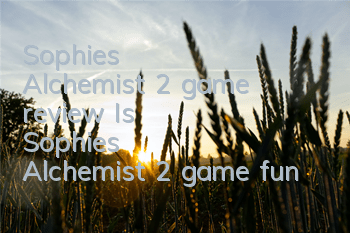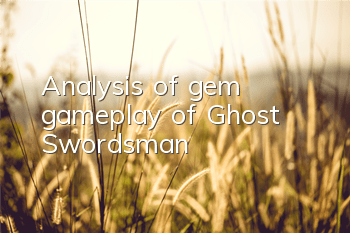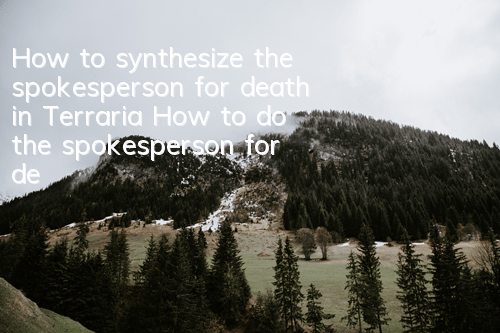Perhaps it feels that after watching the two works, Lesa's "meat legs", the players have developed aesthetic fatigue. In the 25th anniversary of the "Alchemy Workshop" series, GUST Studio chose Sophie, who is the incredible trilogy, as the protagonist. Among the more than 20 previous series of works in "Alchemy Workshop", the only protagonist who has the honor of "sequel" is Lesa, who can become the second person after that, which shows how GUST attaches importance to the role of Sophie.
As an alchemist who was born in a small countryside, Sophie seemed more restrained than Lesa's "unrestrainedness". Her dream is to bring happiness to everyone with alchemy, and the reason why she has always been popular among players in the Alchemy Works Series is precisely because of her tenderness.
The subtitle of this work is called "The Alchemist of the Incredible Dream". Compared with the previous work, there is only a word change from "book" to "dream", and this change also represents a transformation at the core of the story. The so-called "book" is Prafda who was both a teacher and a friend of Sophie in the previous work, transforming from a magic book into a doll, and "dream" means the dreamlike world in this work, and the dream that everyone strives for.
Is this reasonable to use puzzles to alchemy?
The most interesting content in the "Alchemist House" series is that each of it has a new and changing coordination system. Compared to upgrading from monsters, studying alchemy to make powerful equipment props is the best way to improve combat power, which also gives this series a unique experience of "1 hour of alchemy and 5 minutes of BOSS battle". While inheriting the "panel blending" system in the Incredible Series, this game also ushered in some new changes.
The so-called "panel blending" is a mini game similar to a puzzle. Each alchemy material becomes a "tetris" of different colors according to the different attribute components they contain. What players have to do is to tuck these blocks into the panel in the center of the screen as much as possible by rotating and moving, thereby improving the ultimate quality of props.
However, the components of each attribute have the constraints of "early upper limit", which is also to prevent players from making some advanced props in the early stage, which will affect the overall balance of the game. If the initial upper limit cannot be broken, then no matter how much "tetris" is stuffed into it, it will be futile.
Therefore, the core of this alchemy system lies in how to break through the upper limit of components.
The first method is to connect as many of the luminous parts in Tetris with asterisks together as much as possible to unlock a higher upper limit level. This adds to the fun of "water pipe" in addition to the "puzzle" gameplay. As Sophie and his partners become more and more favorable, they can also trigger their partner skills when connecting, bringing various powerful buff effects. This also makes players more willing to study the placement of materials, thereby obtaining the maximum profit.
However, this method still cannot break through the "final upper limit" of the red in the meter. If you want to make a truly top-quality prop, you need to use the second method, which is to take out the difficult "reversal panel". This mode will disable some blocks on the panel, allowing players to tie their hands and feet even more when they are puzzled.
Fortunately, with the "alchemy catalyst", the difficulty of "reversing the panel" will be greatly reduced. These catalysts that can be used unlimitedly can not only increase the capacity of the panel, but also add special rules such as segmentation and reversal, making the system a panel with overlapping components similar to "Litty and Syl's Studio" where overlapping components will not disappear. This effectively improves the utilization rate of high-level materials, and the fun of alchemy has become more abundant.
New Travel in Another World
Sophie, who left her hometown in the finale of the previous work, and she and Prafda were traveling to another world due to an accident. In order to find Prafda who disappeared during the journey, Sophie embarked on an adventure again with her newly met friends.
Similar to the "tradition" of the series, this different world is also composed of a town called Reutil as the center, coupled with different surrounding natural landscapes. However, the size of the town in Loytire is slightly smaller than that of "Lesa 2", and the functionality of the town also makes me feel that it is not complete. Apart from buying and selling goods, copying props, receiving commissions, and doing companion tasks, I have almost nothing to do in the town. I can't find side quests while wandering around the town, or further strengthening weapons through forging, just like in "Lesa 2".
In addition, the plot quality of this work also makes me feel unsatisfied. After the game's mid-game, the plot lacks motivation, and the later plot direction is extremely abrupt and lacks preparation. The final villain was suddenly "mechanical scammers" and temporarily arranged the important task of fighting against the protagonist group. I don’t think such a story can bring any feelings to people, but it will make people feel a little puzzled.
What is even more desperate is that after the final boss battle, if you want to truly end, the player needs to create an ultimate mission prop. To obtain the material to make this prop, you must first unlock almost all the alchemy recipes in the game. You can't imagine how confused I was when I defeated the final boss and waited to watch the ending animation, but I suddenly realized that I had to make a prop that I had never even heard of before. I don't think ordinary players who just want to pass the level should be forced to collect all elements.
Let's talk about Loytire, although it is nominally a "different world", it is not much different from Sophie's original world. The only difference is the extremely special weather.
The weather in each maze area was originally fixed. When players advance the main plot and create specialAfter the special gems, you can use props to transform into weather with specific attributes at the mechanism of the maze, so that some originally blocked sections can also pass smoothly. For example, a dry riverbed on sunny days will accumulate water on rainy days, while a snowy day will freeze into a walking ice surface. This system is somewhat similar to the "super crossbow-level blending" in "Phylis' Studio", and can be said to be a classic return to the incredible series of elements.
However, the settings of some weather mechanisms are not very reasonable. The weather mechanism of the wind element can only play an effect within a range of 10 meters and exists as a "super jump". Compared with other mechanisms that change the scope of the entire picture, the functions of this weather are simple and crude, and lack a sense of design. At the same time, since it cannot be maintained throughout the map like other weather, the weather props of the wind element are consumed faster than other weathers, which often makes me find that the number of times I don’t have enough times during the map, which has had a certain impact on the smoothness of the experience.
There will be obvious blue marking lines on the border of windy weather areas
Unlike Lesa's "Use recipe to unlock recipes" model, Sophie's alchemy formula relies entirely on her own "inspiration". During specific collection, manufacturing, and combat, Sophie will gradually gain inspiration and create new recipes. These recipes will be recorded in the tree diagram of the notes, and only when the player unlocks the low-level recipe first can he see the adjacent high-level recipes.
However, some main plot recipes will be difficult to find some of the props required for the conception due to system design. Some props, such as "Universal Neutralizer·Rainbow", do not indicate the way to obtain them in the picture book, nor do they have a way to obtain prompts through task logs and NPC dialogues, making it difficult to judge whether they can only obtain them through production, purchase, or other means.
This also makes it difficult for me to be interested in exhausting the entire alchemy system
And, all the recipes in this work are divided into two types, one is exclusive to Sophie, and the other is exclusive to Prafda. The two have independent alchemy levels and different props that can be made. However, the two different alchemy techniques are not reflected in the gameplay, making people feel that there is no enough difference. This system also added a lot of unnecessary trouble to me: I usually use Sophie to blend, but only some of the main plot props can be made by Prafda. Because Prafda's level is too low, I always have to use her to repeatedly make many useless props to improve the alchemy level in order to make mission props. This part of the experience is extremely boring, but due to the main line, I have to go through this process, which makes me very depressed.
Six-player turn-based battle
This game does not use the semi-real-time battles of the Lesa series, but returns to the traditional turn-based game of the Incredible series. The most eye-catching change is the "double attack" system that maximizes the use of reserve players.
Our side with a total of 6 peopleIn the team, the three vanguards who directly face the enemy in battle are the two vanguards, while the other 3 are reserve members who do not join the battle. When the player launches a "double attack", one striker can exchange with the reserve player, and the two can also release their skills once each. This finally made the idle teammates who had been sitting on the bench stand out.
When accumulating skill bars through "double attack", players can also activate the joint ultimate skill of two players "double trigger". Different team members can also trigger different ultimate skill effects. Some cause huge damage, while others can make all our members full of blood in an instant. These special moves have gorgeous special effects, and the two people who have activated the "double trigger" will also have special interactive performances in the battle settlement screen, which makes people feel the bond between their companions.
However, this system still has some target selection problems. The skills marked "all our staff" are actually choosing one of the two between "all forwards" and "all reserves". This has actually cut the skill effect of group recovery and adding BUFF by half, and also doubles the number of operations players in this part, making the battle more complicated.
What affects the core strategy of the battle is the "Aura" shield of the BOSS and the Elite Monster. The enemy protected by "spiritual energy" will have super high damage reduction. Only when we attack the weakness first can we break the shield to effectively damage. In addition to the attribute weaknesses of each "spiritual energy", there is also a counterattack against specific attribute damage. If the player ignores the attributes of "spiritual energy", it may cause the boss to launch four or five counterattack skills in one round, easily destroying us.
However, the "Aura" system has no depth, it only allows players to have an extra process of confirming enemy attributes before attacking and selecting specific skills. In actual gameplay, the repetition of the battle is still very high, not to mention that there is a main line boss that appears twice and has almost unchanged mechanisms.
In addition, this game has also made many improvements to facilitate players in the combat system.
What makes me most happy is the change in the Minglei encounters monster mode. The intersections of roads on this game's map are designed as a large open area, and the monsters are gathered in the center, allowing players to take a detour and avoid enemies very easily. This is an epic improvement compared to the monsters in "Lesa 2" who are densely packed on the narrow road and are reluctant to leave. After all, in "Lesa 2", this monster-encountering mode made me angry that I once wanted to throw NS directly.
Another improvement is the built-in acceleration system in turn-based combat. After adjusting to 2 times the speed, the rhythm of the battle has also increased a lot, allowing players who want to upgrade to the monsters to have a better gaming experience.
Overall Comments
Newly upgradedThe post-level blending system is the main fun of "Sophie's Alchemist 2". Collecting materials, conceiving recipes, and thinking about how to make better props often makes me spend hours without realizing it. This game has given unique innovations for the classic turn-based combat mode, and the improvements in the monster-catching mode also make me very happy. I can be more devoted when collecting materials and running pictures.
Unfortunately, the plot, some main line props that are too difficult to produce, some materials that are difficult to find when conceiving the formula, and the unreasonableness of the two-player alchemy system have all caused a significant damage to the experience of this game, which restricts it from becoming an excellent enough game. However, for fans of the "Alchemy Workshop" series, especially those who have played "Sophie 1", this game is still a very worthy work to try.
A last attached CG that can trick people into the trap
For more related information, please pay attention to: Sophie's Alchemist's Room 2: The Unbelievable Dream of Alchemist's Zone









